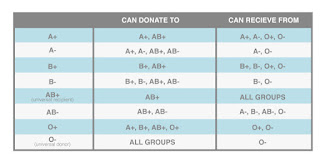 |
| https://qph.fs.quoracdn.net/main-qimg-23177 8370c524deac0b6b95e6a65bc48-pjlq |
Finding a donor heart is difficult. The heart must be
donated by someone who is clinically dead, but on life support. This mean being
brain dead, including the absence of spontaneous breathing, and maintain basic
functions by being
connected to a ventilator.
 |
| https://thrombolux.com/wp-content/uploads/2018/08/ABO-blood-groups-2-768x494.png |
 |
| https://www.veritasint.com/blog/wp-content/uploads/2021/06/10.-How-blood-groups-are- inherited-and-why-its-important-that-you-know-yours_Cuadro_blog1_ENG-768x388.jpg |
A heart transplant MAY BE DONE TO TREAT:
/ Serious damage to the heart after a heart attack
/ Severe heart failure (the heart does not contract
properly, pumping very little blood to the body) with poor quality of life, and
no response to pharmacological treatment or conventional surgery.
/ Serious heart abnormalities that were present at birth
(congenital) and cannot be repaired with surgery
/ Abnormal and life-threatening palpitations or rhythms
that do not respond to other treatments
Other conditions must also be evaluated individually to see possible risks:
age, malnutrition, diabetes, people
who have had cancer less than two years ago, advanced lung
disease, people who have had a severe stroke, advanced
liver disease, dementia, chronic
kidney disease, HIV infection, active hepatitis…
/ To perform the transplant, the person receives general
anesthesia.
/ The thorax is opened by making a cut through the
sternum.
/ In order to work on the heart, it must be stopped. The blood passes through an extracorporeal circulation
system, which does the work of the heart and lungs, while the surgeon works on
the heart. This machine supplies the body with blood and oxygen.
/ The diseased heart is removed and replaced with the
donated heart.
/ The extracorporeal circulation machine is disconnected so
that the blood begins to pass through the transplanted heart and supply blood
and oxygen to the body.
 |
| https://www.mayoclinic.org/-/media/kcms/gbs/patient-consumer/images /2016/06/01/09/10/mcdc_heart-transplant-surgery-8col.jpg |
The MAIN RISKS of transplantation are:
/ Acute
rejection. The body produces a
defense reaction (immune) against an organ that is not its own and if it is not
controlled it can destroy it. To avoid this, medications that decrease the
immune response must be administered. Rejection is more frequent in the first
months.
/ Heart rhythm
problems
/ Infections:
they are the main cause of death after heart transplantation.
/ Cancer: immunosuppressive drugs increase the risk of cancer
/ High
cholesterol levels, diabetes, and
thinning of the bones from the use of anti-rejection medications
/ Immunosuppressant
toxicity: Some of these drugs can cause high blood pressure, kidney
failure, or liver failure.
/ Lung and kidney
failure.
About 80% of patients are still alive 2 years after the
operation. At 5 years, more than 70% of patients will still be alive after this
transplant. The main problem is rejection. If the rejection can be controlled,
survival can be increased to more than 10 years. In recent years the results are much better. Heart transplantation offers a chance to lead an active
and reasonably normal life
HISTORY
AND LEGISLATION
In
1967, the first heart transplant was performed on a 54-year-old patient by Dr. Christiaan Neethling Barnard.
This person died 13 days after the operation. Dr. Barnard
performed a second transplant and the person died 18 months later. It was shown
that after a transplant, it was possible to live with another person's heart,
being able to recover normal physical and intellectual activity. The first results were not good.
 |
| https://media2.nekropole.info /2013/12/Christiaan-Barnard.jpg |
Richard Lower and Norman Shumway developed the surgical technique for heart transplantation in 1965. This technique is still used today.
 |
| http://www.scielo.org.za/scielo.php?script=sci_arttext&pid=S0256-95742011000200010 |
In 1984, Spain joined the heart transplant programs.
Today, there are 19 hospitals where transplants are performed in Spain. Spain is the world leader in organ transplantation for 28
years.
The Spanish model has been at the forefront of the world
in organ donation and transplantation for 28 years. It is the world leader,
with 15 daily transplants, 20% of all donations from the European Union and 6%
of world donations.
The Law 30/1979 of October 27 is the one currently in force. It establishes the
basic principles of gratuity, equality, non-discrimination and preserving the
dignity of the donor and recipient, among others.
 |
| https://www.healthcare-economist.com/wp-content/uploads/2019/10/donationrates2.jpg |

